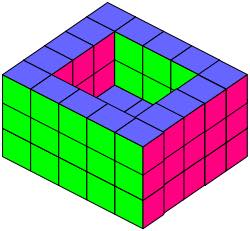Skip over navigation

Here is a small open box made out of little cubes.
It is 5 cubes wide, 5 cubes long and 3 cubes high.
It is just 1 cube thick everywhere.
Work out how many little cubes were used to make the open box in the picture.
Challenge 2
Challenge 3
You have 112 little cubes.
Imagine that you are asked to make more open boxes which are 1 cube thick, always with a width between 3 and 5 cubes inclusive, the length between 10 and 20 cubes inclusive and the height of 2 or 3 cubes.
What size open boxes could you make if you have to use all 112 cubes?
Challenge 4
If open boxes have to be 1 cube thick, have a width of 3, 4 or 5 cubes inclusive, the length between 10 and 20 cubes inclusive and the height of 2 or 3 cubes (as in the previous challenge), what sizes use exactly 144, 146 and 147 little cubes?

Or search by topic
Number and algebra
Geometry and measure
Probability and statistics
Working mathematically
Advanced mathematics
For younger learners
Open Boxes
Age 7 to 11
Challenge Level 






Here is a small open box made out of little cubes.
It is 5 cubes wide, 5 cubes long and 3 cubes high.
It is just 1 cube thick everywhere.
Challenge 1
Work out how many little cubes were used to make the open box in the picture.
Challenge 2
If you were going to make a bigger box that is 5 cubes wide, 12 cubes long, 3 cubes high and just 1 cube thick, how many little cubes would you need?
Challenge 3
You have 112 little cubes.
Imagine that you are asked to make more open boxes which are 1 cube thick, always with a width between 3 and 5 cubes inclusive, the length between 10 and 20 cubes inclusive and the height of 2 or 3 cubes.
What size open boxes could you make if you have to use all 112 cubes?
Challenge 4
If open boxes have to be 1 cube thick, have a width of 3, 4 or 5 cubes inclusive, the length between 10 and 20 cubes inclusive and the height of 2 or 3 cubes (as in the previous challenge), what sizes use exactly 144, 146 and 147 little cubes?
You may also like
Geoboards
This practical challenge invites you to investigate the different squares you can make on a square geoboard or pegboard.

